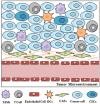The mechanisms and reversal strategies of tumor radioresistance in esophageal squamous cell carcinoma
- PMID: 33687564
- PMCID: PMC11801892
- DOI: 10.1007/s00432-020-03493-3
The mechanisms and reversal strategies of tumor radioresistance in esophageal squamous cell carcinoma
Abstract
Esophageal squamous cell carcinoma (ESCC) is one of most lethal malignancies with high aggressive potential in the world. Radiotherapy is used as one curative treatment modality for ESCC patients. Due to radioresistance, the 5-year survival rates of patients after radiotherapy is less than 20%. Tumor radioresistance is very complex and heterogeneous. Cancer-associated fibroblasts (CAFs), as one major component of tumor microenvironment (TME), play critical roles in regulating tumor radioresponse through multiple mechanisms and are increasingly considered as important anti-cancer targets. Cancer stemness, which renders cancer cells to be extremely resistant to conventional therapies, is involved in ESCC radioresistance due to the activation of Wnt/β-catenin, Notch, Hedgehog and Hippo (HH) pathways, or the induction of epithelial-mesenchymal transition (EMT), hypoxia and autophagy. Non-protein-coding RNAs (ncRNAs), which account for more than 90% of the genome, are involved in esophageal cancer initiation and progression through regulating the activation or inactivation of downstream signaling pathways and the expressions of target genes. Herein, we mainly reviewed the role of CAFs, cancer stemness, non-coding RNAs as well as others in the development of radioresistance and clarify the involved mechanisms. Furthermore, we summarized the potential strategies which were reported to reverse radioresistance in ESCC. Together, this review gives a systematic coverage of radioresistance mechanisms and reversal strategies and contributes to better understanding of tumor radioresistance for the exploitation of novel intervention strategies in ESCC.
Keywords: ESCC; Mechanisms; Molecular targets; Radioresistance; Reversal strategies.
Conflict of interest statement
The authors declare that they have no conflict of interests.
Figures



Similar articles
-
WISP1 drives esophageal squamous cell carcinoma progression via modulation of cancer-associated fibroblasts and immune microenvironment.Front Immunol. 2025 Jul 23;16:1586790. doi: 10.3389/fimmu.2025.1586790. eCollection 2025. Front Immunol. 2025. PMID: 40771797 Free PMC article.
-
Hypoxia-induced exosomal circNRIP1 activates cancer-associated fibroblasts to promote esophageal squamous cell carcinoma migration and invasion.BMC Gastroenterol. 2025 Aug 20;25(1):605. doi: 10.1186/s12876-025-03978-w. BMC Gastroenterol. 2025. PMID: 40836210 Free PMC article.
-
YAP as a therapeutic target in esophageal squamous cell carcinoma: insights and strategies.Ann Med. 2025 Dec;57(1):2536200. doi: 10.1080/07853890.2025.2536200. Epub 2025 Jul 22. Ann Med. 2025. PMID: 40693409 Free PMC article. Review.
-
Targeting Drp1 inhibits ESCC progression via the ROS-PGC1-α-Nrf1/2 pathway.J Transl Med. 2025 Jun 17;23(1):674. doi: 10.1186/s12967-025-06697-8. J Transl Med. 2025. PMID: 40528181 Free PMC article.
-
Tislelizumab for the treatment of advanced esophageal squamous cell carcinoma.Future Oncol. 2025 May;21(12):1473-1481. doi: 10.1080/14796694.2025.2495542. Epub 2025 Apr 21. Future Oncol. 2025. PMID: 40257370 Review.
Cited by
-
The roles and mechanisms of the lncRNA-miRNA axis in the progression of esophageal cancer: a narrative review.J Thorac Dis. 2022 Nov;14(11):4545-4559. doi: 10.21037/jtd-22-1449. J Thorac Dis. 2022. PMID: 36524088 Free PMC article. Review.
-
CD155 promotes radioresistance and malignancy of esophageal cancer by regulating Hippo-YAP pathway.Discov Oncol. 2022 Jun 29;13(1):53. doi: 10.1007/s12672-022-00515-z. Discov Oncol. 2022. PMID: 35768666 Free PMC article.
-
Role of circular RNAs in the diagnosis, regulation of drug resistance and prognosis of lung cancer.Oncol Lett. 2022 Jul 7;24(3):302. doi: 10.3892/ol.2022.13422. eCollection 2022 Sep. Oncol Lett. 2022. PMID: 35949591 Free PMC article. Review.
-
Hedgehog signaling and the glioma-associated oncogene in cancer radioresistance.Front Cell Dev Biol. 2023 Nov 13;11:1257173. doi: 10.3389/fcell.2023.1257173. eCollection 2023. Front Cell Dev Biol. 2023. PMID: 38020914 Free PMC article. Review.
-
Long non-coding RNA OIP5-AS1 promotes the progression of esophageal cancer by regulating miR-30a/VOPP1 expression.Oncol Lett. 2021 Sep;22(3):651. doi: 10.3892/ol.2021.12912. Epub 2021 Jul 9. Oncol Lett. 2021. PMID: 34386073 Free PMC article.
References
-
- Alajez NM, Shi W, Hui ABY, Yue S, Ng R, Lo KW, Bastianutto C, O’Sullivan B, Gullane P, Liu FF (2009) Targeted depletion of BMI1 sensitizes tumor cells to P53-mediated apoptosis in response to radiation therapy. Cell Death Differ 16:1469–1479 - PubMed
-
- Bao C-H, Wang X-T, Ma W, Wang N-N, Nesa EU, Wang J-B, Wang C, Jia Y-B, Wang K, Tian H, Cheng Y-F (2015) Irradiated fibroblasts promote epithelial-mesenchymal transition and HDGF expression of esophageal squamous cell carcinoma. Biochem Biophys Res Commun 458:441–447 - PubMed
-
- Bray F, Ferlay J, Soerjomataram I, Siegel RL, Torre LA, Jemal A, Global cancer statistics (2018) GLOBOCAN estimates of incidence and mortality worldwide for 36 cancers in 185 countries. Ca-a Cancer J Clin 68(2018):394–424 - PubMed
-
- Chen M-F, Lu M-S, Lin P-Y, Chen P-T, Chen W-C, Lee K-D (2012b) The role of DNA methyltransferase 3b in esophageal squamous cell carcinoma. Cancer 118:4074–4089 - PubMed
-
- Chen M-F, Lu M-S, Chen P-T, Chen W-C, Lin P-Y, Lee K-D (2012a) Role of interleukin 1 beta in esophageal squamous cell carcinoma. J Mol Med 90:89–100 - PubMed
Publication types
MeSH terms
Substances
Grants and funding
LinkOut - more resources
Full Text Sources
Other Literature Sources
Medical

